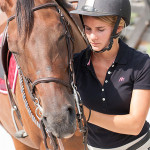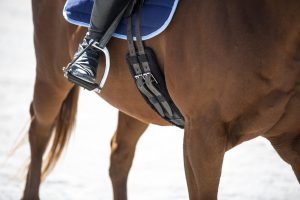In this week’s video we are covering another “everyday” horse skill that can be an area of problems and frustrations for many people – putting on the bridle. For those of us who have been riding for years it may seem like a simple task, but in the beginning it took a bit of work to figure out how to hold the bridle, open the horse’s mouth, and slide the bit in. Add a horse who likes to lift his head and bridling can become a real challenge!
In this short video, I simply show you what I have found to be the easiest way to put a bridle on, plus share a few tips for managing the hard to bridle horse.
Enjoy!














10 Responses
Great videos, Callie. I have had to up my riding skills since I got a new horse recently, and the videos have been very helpful. In bridling a new horse who I don’t know well, I usually unbuckle the halter, release the horse’s nose, and slide the halter back, buckling it on his neck. Then I take the halter off after the bridle is on. Is there any reason why this isn’t a good method? And thanks again for your thoughtful and very helpful videos!
Hi Nancy,
This is a fine method. I have seen where sometimes the halter is left connected to crossties or ties and I don’t recommend doing this because it increases the risk of injury to the horse’s neck should they pull back.
Great info here, but any extra bridling tips for a tall horse (or a short person)?? I nearly throw out my shoulder trying to bridle a tall horse…what am I doing wrong? Thank you!!
Hi Cat, Good question! The best solution is to teach the horse to lower their head so that you can rest your arm between their ears like I do with Molly. I will do another video on teaching a horse to lower their head because there are several ways you can do this. I have found the easiest way is to rest your hand on their poll (or as high on the neck as you can reach), most horses will naturally start moving their head around and when they lower their head you say good, take your hand off and give them a little treat. This method is essentially using clicker training, lowering the head can also be taught with just pressure on the top of the head, and releasing that pressure when the horse lowers his head, but I have found that adding the positive reinforcement with the treat helps horses that get “stuck” with their head up braced against the pressure from your hand. Like I said, I will make a video on this one soon! Thanks for giving me the idea!
I”m going to try putting my arm on the poll. I hadn’t ridden my daughter’s horse in a while. The last time I did, he jerked his head up before I got the bridle out. He freaked out, spit out the bridle, and backed up (I was in super early so no horses ir people were in the aisle). I let him free until I could grab the halter (everything seems so seamless when my daughter does it!). I (amazingly) kept pretty calm while he backed up, though I was shaking inside. I will try the hand on the poll once I get him to understand what that means. Thank you!
I’ve taken some lessons recently at a barn and my mount was very difficult to accept the bit. He would drop his head but he would not open his mouth. The instructor was able to get him bridled, but he refused to open his mouth for me. I tried tickling the roof of his mouth with my thumb and still he clamped his mouth tight as a drum. We opted to ride him with a bitless bridle that the instructor had recently purchased and she claims he was the best she had ever seen him while I rode him with it. I’m actually considering getting one for my mare.
Hello!
I really love your videos and your advice. I have an OTTB who has been off the track since 2008 and he was used in a lesson program. He is awesome under saddle, does not give any fuss, but he does give me major issue when I am trying to bridle him. First it was he was head shy, but he would take the bit fine. I have worked on teaching him to lower his head and he has also had a chiropractor work on him as well (he had pain in his pole), well now he refuses to take the bit and when I finally do get it in his mouth he if perfectly fine, grumpy as all heck but fine. He had his teeth done a few months ago so I know that is not the issue, and his old owners told me he never did this with them. So I am at a loss as to why he has developed this new behavior, our first ride together he bridled like a dream! but after that it was bad. I am still working with him every day but I feel like I am getting no where. When we are done riding, and I am taking off the bridle he just wont let go of the bit and drop it out of his mouth, I am so confused. I have never hit his teeth with it, and I have no clue where this behavior came from at all. What would you advise?
I have had several OTTBs with a rather unusual aversion to bits, I suspected it was related to a lot of bad experiences with them. I would consider trying a rubber bit – I really like the Nathe rubber bits – they are much smaller and softer than other rubber ones. Many of the horses that are evasive with other types of bits really take to them. I would say it is worth a try.
Hi Callie,
My horse instructor sent me to your video. I am a first time horse owner with a Tennessee Walker mare. Lately she’s been giving me attitude and wouldn’t even let me put her headstall on. I don’t have a nose and on mine, but this video is still super helpful. I plan on trying both techniques, but I may have to do some extra work without the headstall, like you mention.
Jesse,
Keep us updated on your progress with your mare!
-Julia Burdy, CRK Training Community Manager